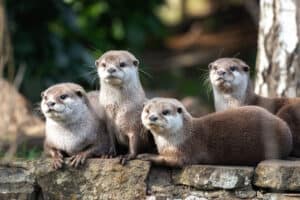You can almost see this jaguar’s mind working as it weighs up the possibilities of the situation. It is high up on a riverbank, gazing down at some river otters in the water below. They are bobbing up and down in a hilarious synchronized water dance and are in no hurry to get away from this predator. Meanwhile, the big cat peers down at them, trying to work out if they are entertainment or lunch. It is also calculating whether it would be able to get into the water quickly enough to catch one and how it would get back out of the water with an otter in its mouth!
See the Video Here
All About River Otters
According to the video notes these are giant otters (Pteronura brasiliensis) which are native to South America and are also called ariranha, river wolf, and water dog. They are one of the 13 different species of otters that exist worldwide. These very special animals can grow up to six feet in length and live only in the rivers and creeks of the river systems of the Amazon, Orinoco, and La Plata Rivers. They have been hunted excessively and the population has declined.
They are perfectly adapted for life in the water with powerful tails and long bodies for swimming, webbed feet, and flexible streamlined bodies. In addition, they have webbed feet and water-repellent fur and their nostrils and ears can close to keep out the water!

Giant otters have between one and six young in each litter
©ThiagoSantos/Shutterstock.com
Giant Otter Hunting and Family Life
As you see in this short clip, giant otters live in groups. These are made up of a monogamous breeding pair (mom and dad) and their offspring from several seasons. When they are not in the water, they are hanging out in their dens which are burrows in riverbanks or spaces between logs. They can be very aggressive about defending the den when they are disturbed. The females give birth to between one and six young who start to venture out of the den once they are about a month old.
They need to consume around six to nine pounds of food a day. This is mostly made up of fish and they can hunt these alone or as a group. However, they have also been seen catching and eating crustaceans and even snakes!
The photo featured at the top of this post is © Johnny Giese/Shutterstock.com
Thank you for reading! Have some feedback for us? Contact the AZ Animals editorial team.






